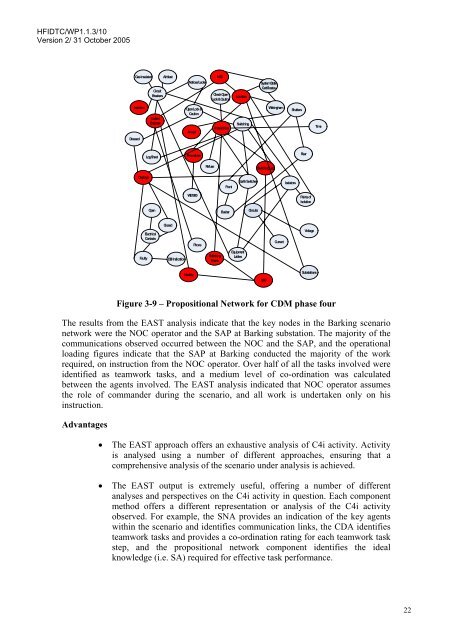A Review of the Event Analysis of Systemic Teamwork Methodology
A Review of the Event Analysis of Systemic Teamwork Methodology
A Review of the Event Analysis of Systemic Teamwork Methodology
- No tags were found...
You also want an ePaper? Increase the reach of your titles
YUMPU automatically turns print PDFs into web optimized ePapers that Google loves.
HFIDTC/WP1.1.3/10<br />
Version 2/ 31 October 2005<br />
Gas Insulated<br />
Circuit<br />
Breakers<br />
Airblast<br />
Notices/Locks<br />
NOC<br />
Check Open<br />
Lock & Caution<br />
Location<br />
SystemState<br />
Certificates<br />
Isolation<br />
Control<br />
Engineer<br />
Open Lock &<br />
Caution<br />
Accept<br />
Instructions<br />
Switching<br />
Wokingham<br />
Shutters<br />
Time<br />
Dressed<br />
Log Sheet<br />
Procedures<br />
Rear<br />
Refuse<br />
Switching Log<br />
Displays<br />
Front<br />
Earth Switches<br />
Isolators<br />
WE1000<br />
Points <strong>of</strong><br />
Isolation<br />
Open<br />
Busbar<br />
Circuits<br />
Electrical<br />
Contacts<br />
Closed<br />
Phone<br />
Current<br />
Voltage<br />
Faulty<br />
DBI Indication<br />
Switching<br />
Phone<br />
Equipment<br />
Lables<br />
Identity<br />
SAP<br />
Substations<br />
Figure 3-9 – Propositional Network for CDM phase four<br />
The results from <strong>the</strong> EAST analysis indicate that <strong>the</strong> key nodes in <strong>the</strong> Barking scenario<br />
network were <strong>the</strong> NOC operator and <strong>the</strong> SAP at Barking substation. The majority <strong>of</strong> <strong>the</strong><br />
communications observed occurred between <strong>the</strong> NOC and <strong>the</strong> SAP, and <strong>the</strong> operational<br />
loading figures indicate that <strong>the</strong> SAP at Barking conducted <strong>the</strong> majority <strong>of</strong> <strong>the</strong> work<br />
required, on instruction from <strong>the</strong> NOC operator. Over half <strong>of</strong> all <strong>the</strong> tasks involved were<br />
identified as teamwork tasks, and a medium level <strong>of</strong> co-ordination was calculated<br />
between <strong>the</strong> agents involved. The EAST analysis indicated that NOC operator assumes<br />
<strong>the</strong> role <strong>of</strong> commander during <strong>the</strong> scenario, and all work is undertaken only on his<br />
instruction.<br />
Advantages<br />
• The EAST approach <strong>of</strong>fers an exhaustive analysis <strong>of</strong> C4i activity. Activity<br />
is analysed using a number <strong>of</strong> different approaches, ensuring that a<br />
comprehensive analysis <strong>of</strong> <strong>the</strong> scenario under analysis is achieved.<br />
• The EAST output is extremely useful, <strong>of</strong>fering a number <strong>of</strong> different<br />
analyses and perspectives on <strong>the</strong> C4i activity in question. Each component<br />
method <strong>of</strong>fers a different representation or analysis <strong>of</strong> <strong>the</strong> C4i activity<br />
observed. For example, <strong>the</strong> SNA provides an indication <strong>of</strong> <strong>the</strong> key agents<br />
within <strong>the</strong> scenario and identifies communication links, <strong>the</strong> CDA identifies<br />
teamwork tasks and provides a co-ordination rating for each teamwork task<br />
step, and <strong>the</strong> propositional network component identifies <strong>the</strong> ideal<br />
knowledge (i.e. SA) required for effective task performance.<br />
22
















